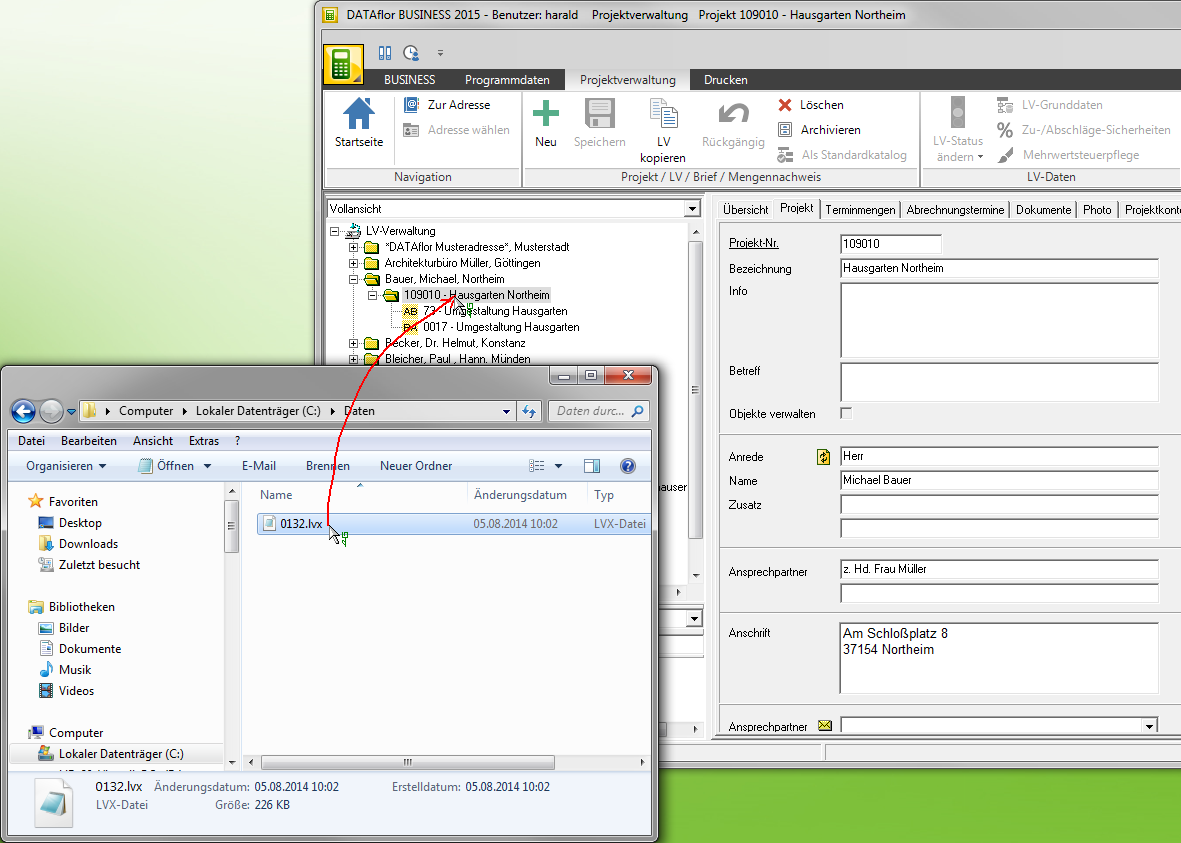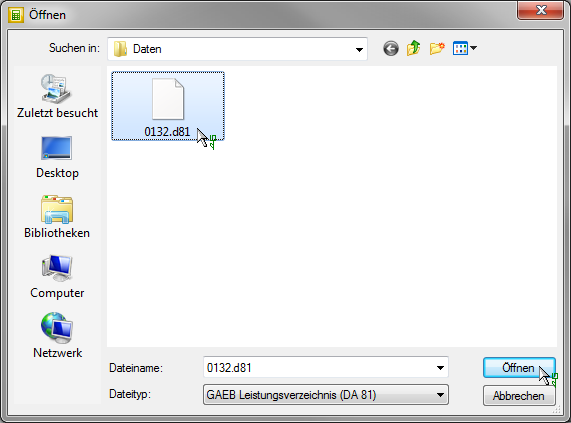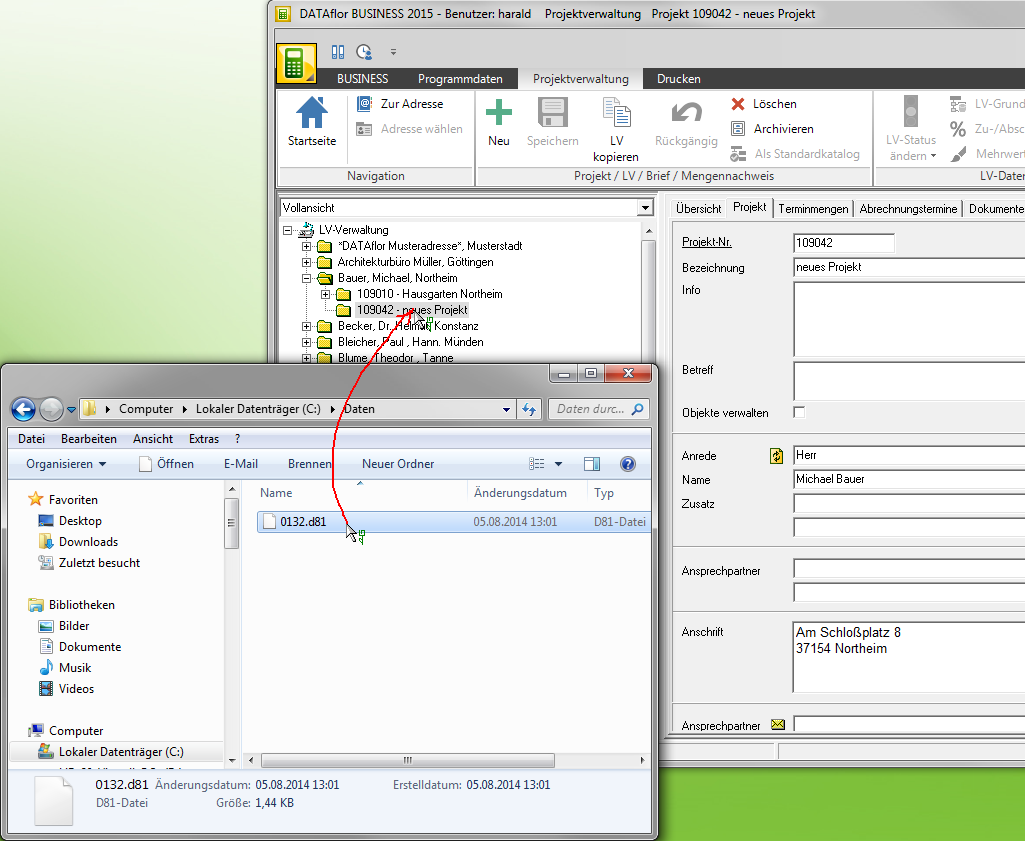Table of Contents
Course exchange
Description
The following interfaces are available for exchanging service specifications:
DATAflor-Directions of services
With the functions Export LV, Import LV (copy) and Import LV (replacement) you can with others BUSINESSUsers DATAflor- Exchange service specifications.
Ab BUSINESS Version 1.0.21.x you can exchange LV regardless of the program version.
Export LV
For exchanging data with others BUSINESS-Users can send service specifications in LV format DATAflor export. The recipient can then use the import specification (copy) and import specification (replacement) function to read in the specification of services.
To export a course, select the course in the project management, open in the menu Project management the selection menu LV and select the entry Export LV.
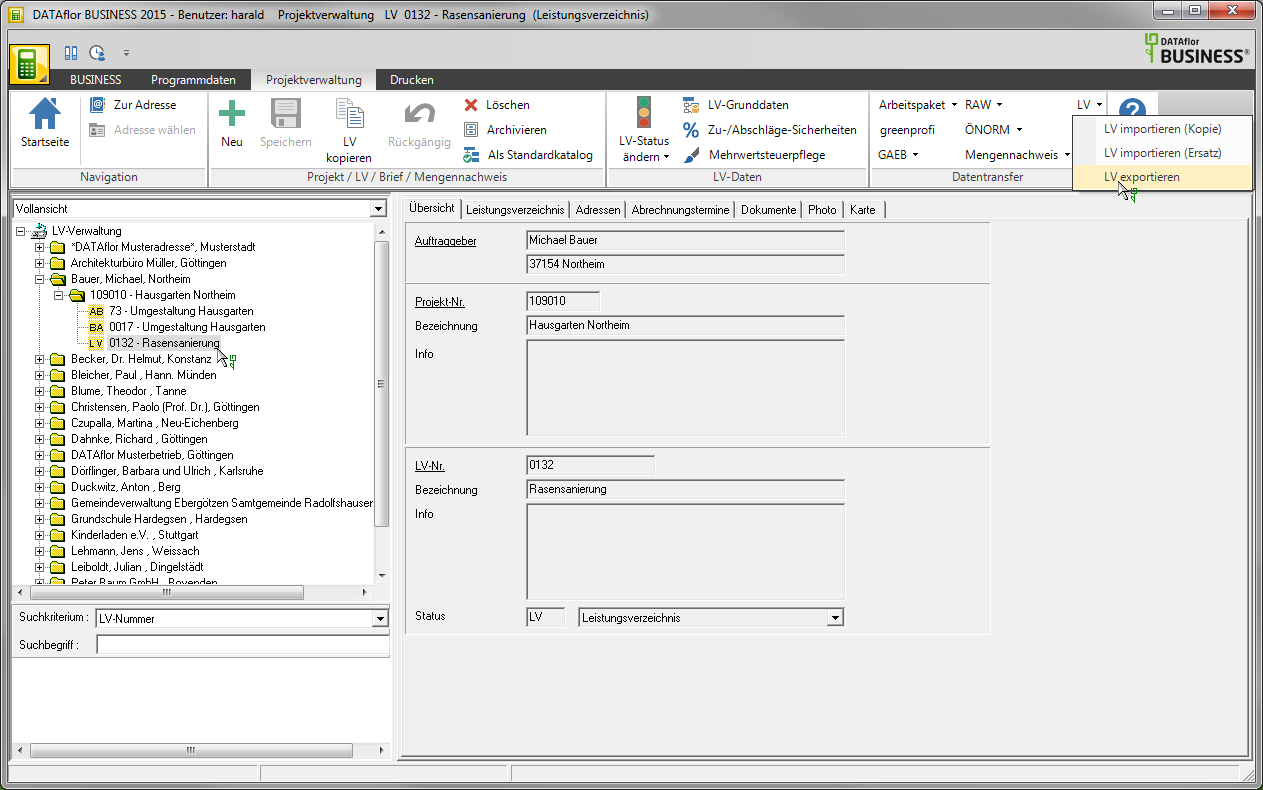
The following export dialog opens.
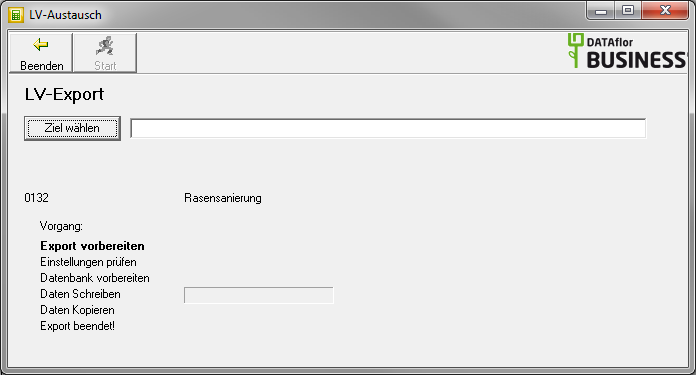
Enter the directory path in which you would like to save your LV or click on [Choose destination]to open the Windows file selection dialog.
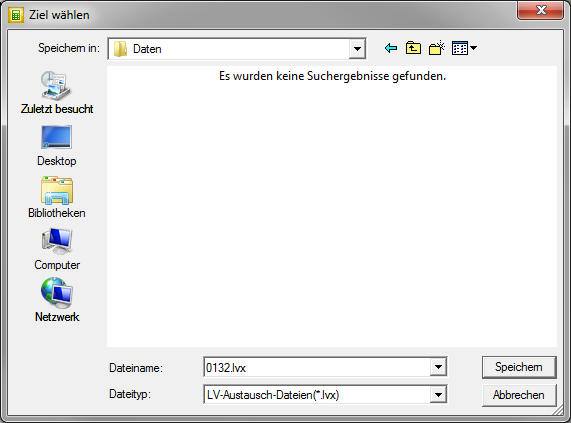
Select where to save the file. The LV number is preset as the file name. Confirm your selection with [To save]. The selected directory path is adopted in the export dialog.
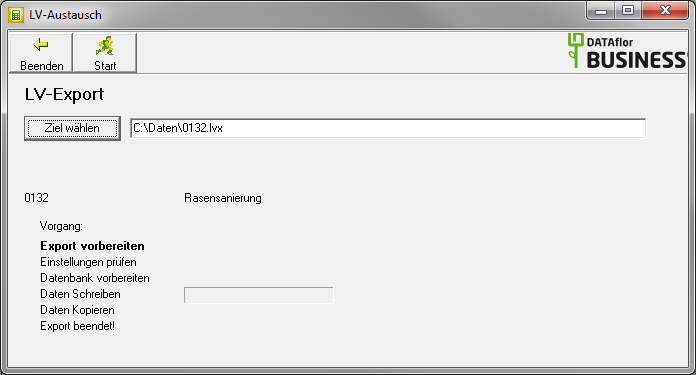
To start the export process, click on  and the file is written. After a successful LV export, close the export dialog by clicking on
and the file is written. After a successful LV export, close the export dialog by clicking on  .
.
Import LV (copy)
With this function you can add a specification of services to a project that was previously created by another BUSINESS-User was exported.
To do this, first select the project in the project management for which you want to import the LV. Then open the menu Project management and the Selection menu LV and select the entry Import LV (copy).

The following import dialog opens.
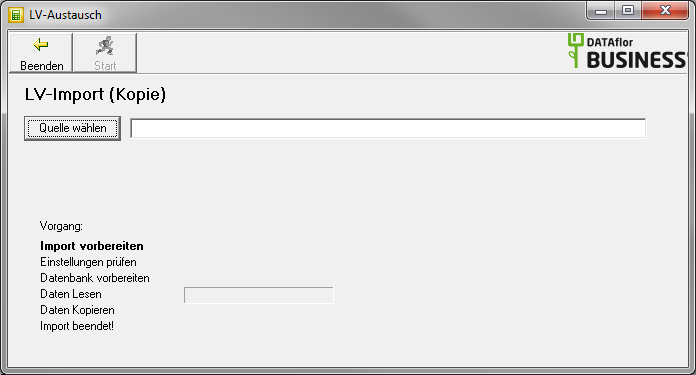
Enter the directory path in which the exported LV is saved or click on [Choose source]to open the Windows file selection dialog.
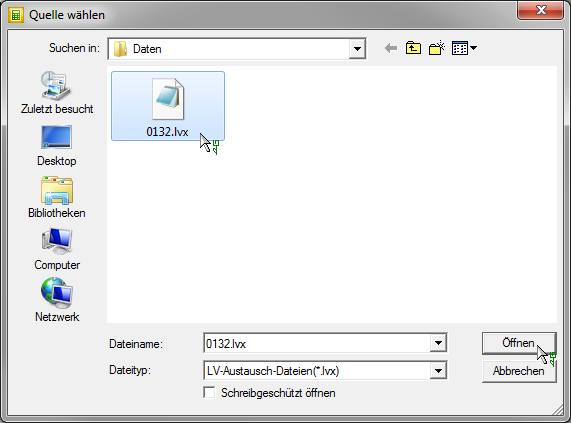
Select the file with the exported LV and confirm with [To open]. The selected directory path is adopted in the import dialog.
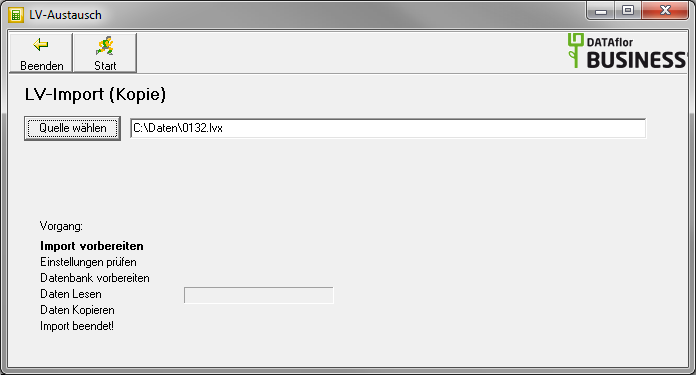
click on  to start the import process. After a successful LV import, close the import dialog by clicking on
to start the import process. After a successful LV import, close the import dialog by clicking on  . The imported LV is displayed in the project management in the selected project.
. The imported LV is displayed in the project management in the selected project.
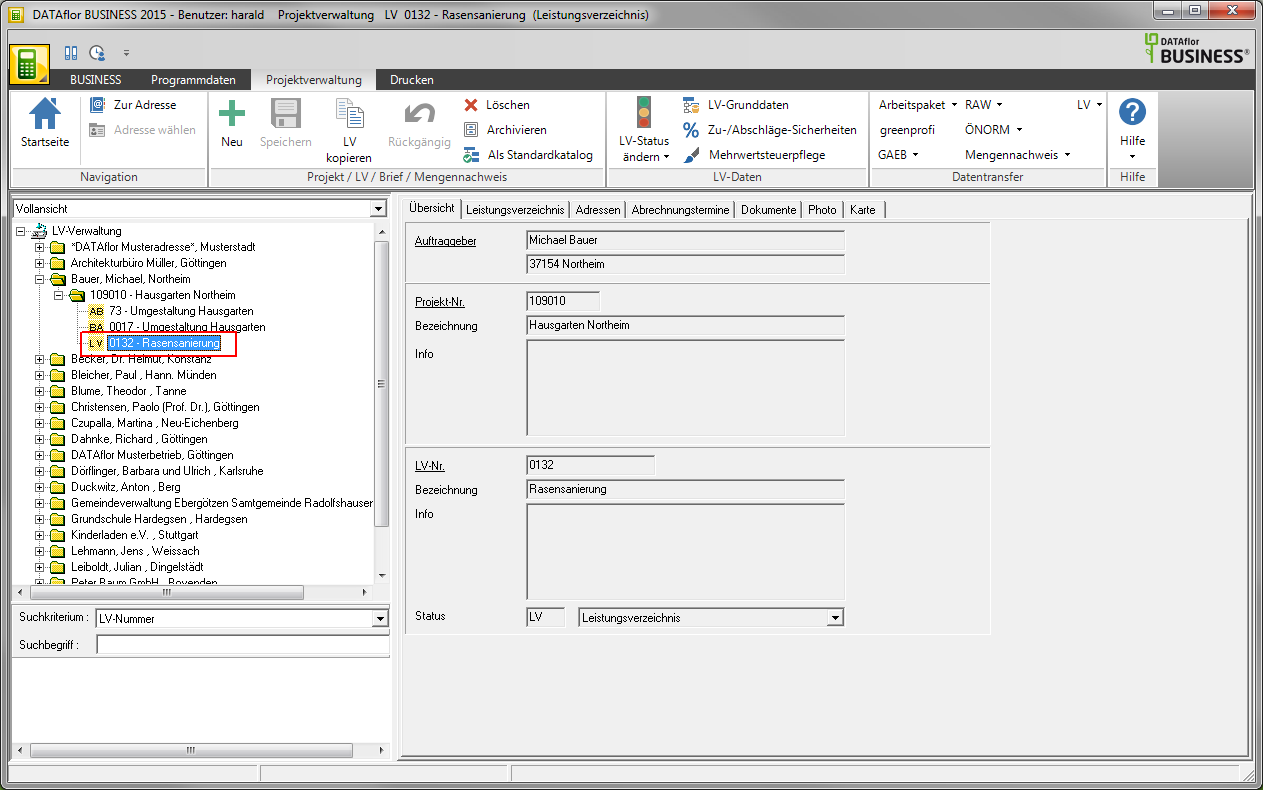
Import LV (replacement)
You use this function to make changes to an existing course.
The transfer takes place on the basis of the position number comparison. It is therefore important that the LV is not renumbered, that no position is deleted or inserted, and that the prices are not changed. Such changes cannot be checked by the program. Be careful with it accordingly. If the item number is not yet available, the item is created again and taken over completely with calculation data.
To import the changes to a LV, first select the LV in the project management for which you want to import the changes. Then open the menu Project management the selection menu LV and select the entry Import LV (replacement).

The following import dialog opens.
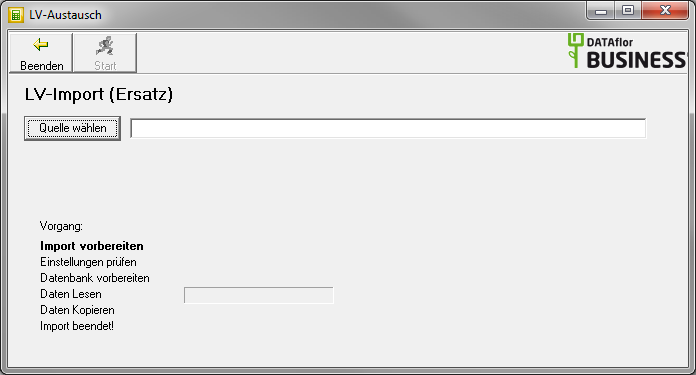
Enter the directory path in which the exported LV is saved or click on [Choose source]to open the Windows file selection dialog.
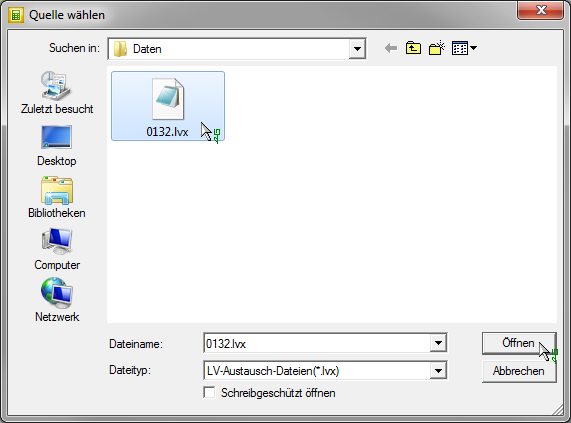
click on  to start the import process. After a successful LV import, close the import dialog by clicking on
to start the import process. After a successful LV import, close the import dialog by clicking on  . The changes are displayed in the position data of the selected course.
. The changes are displayed in the position data of the selected course.
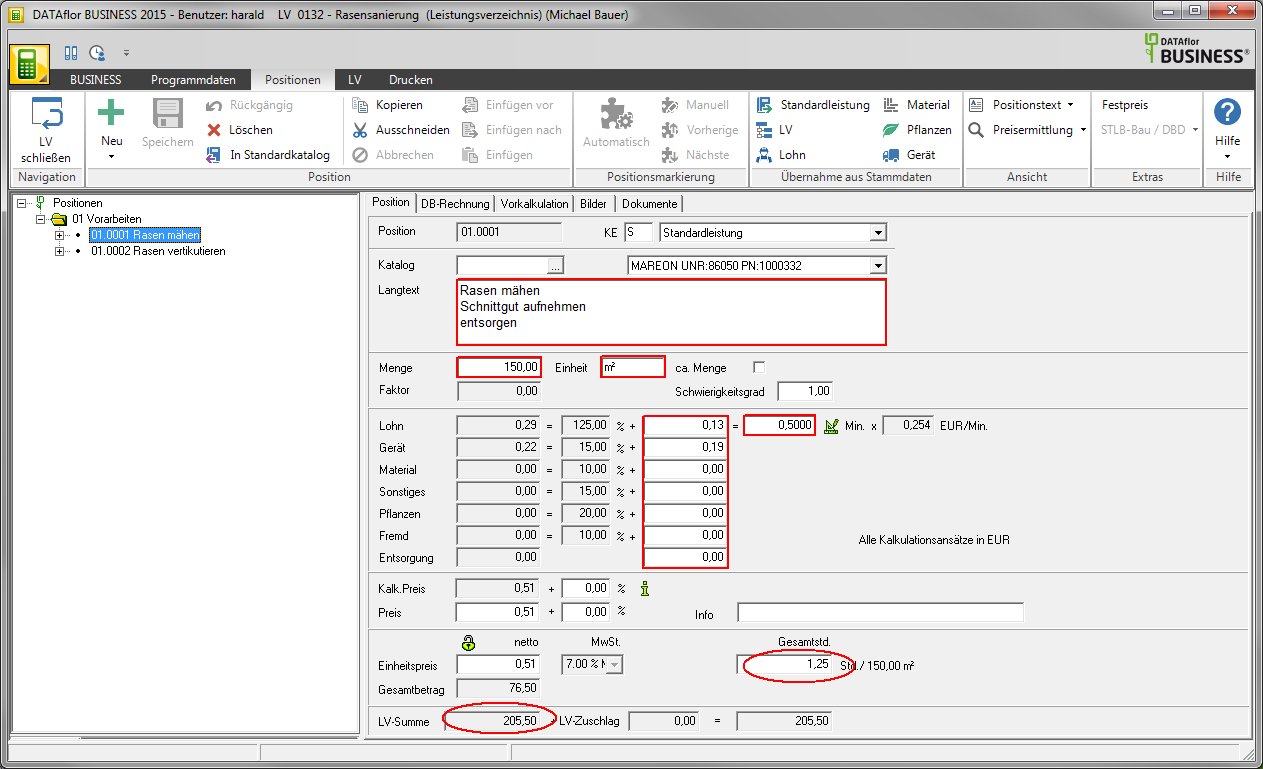
With the new values, the course sum and the total hours are recalculated.
GAEB interface
The Gcommon Acommittee Eelectronics in Bauwesen (GAEB) has set itself the task of promoting rationalization in the construction industry by means of automated data processing. It includes representatives of public and private clients, architects and engineers as well as the construction industry.
For the standardized exchange of data between the contracting authority (architect / authorities) and the construction company (GaLaBau company), the construction information is saved in files with a uniform format. These can be read in and further processed in any software that has a GAEB interface. BUSINESS supports the formats GAEB 90 and GAEB XML.
Exchange phases
You can export and import the following exchange phases:
| 81 | Specifications |
| 82 | Cost estimate based on partial services (positions) |
| 83 | Request for quotation (the invitation to tender received by the gardener and landscaper) |
| 84 | Submission of an offer (the offer made by the gardener and landscaper) |
| 85 | Side offer |
| 86 | Surcharge / placing of order (the award specification drawn up by the architect) |
For billing purposes, you can enter and export quantity statements for GAEB-LV in the REB 23.003 format.
The principles of data exchange are regulated in the GAEB. There are many “can” provisions that may not be met by every program. Before exchanging data, we recommend that you ensure that the importing program can process the functions used.
Classification scheme
The classification scheme of LV in GAEB 90 format can consist of a maximum of 9 characters, LV in GAEB XML format of a maximum of 14 characters.
Unsupported item types
The following item types are not available in GAEB-LV:
| PS | Plant sum |
| PL | Plant list |
| SF | Standard performance factor position |
| SFE | Standard service factor position unit price |
| ZW | Subtotal |
| T* | all day wage positions |
Import GAEB file
With this function you can create service specifications in the format GAEB 90 and GAEB XML in BUSINESS Read.
To do this, mark the project or object in the project management for which you want to read in the GAEB-LV. Then open the menu Project management the selection menu he grunted and select the entry Import GAEB-LV.

The following window will open. To select a file, click on [To open].
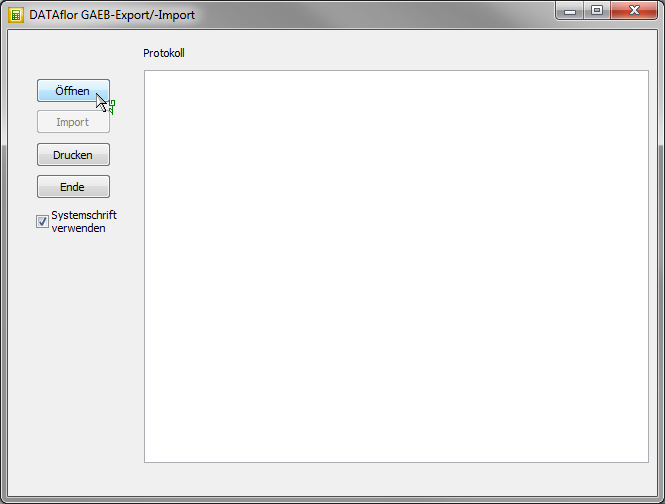
Select the storage location of the GAEB file to be imported and confirm with [To open].
The GAEB files of the selected file type are displayed.
Start the GAEB import by clicking on [Import].
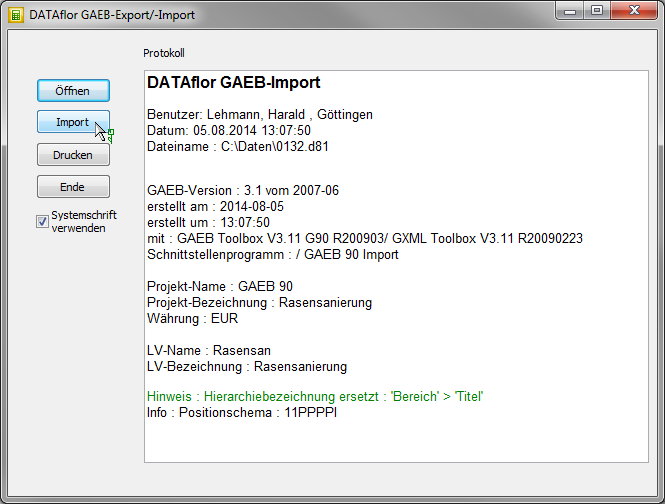
Confirm the GAEB import with [OK].
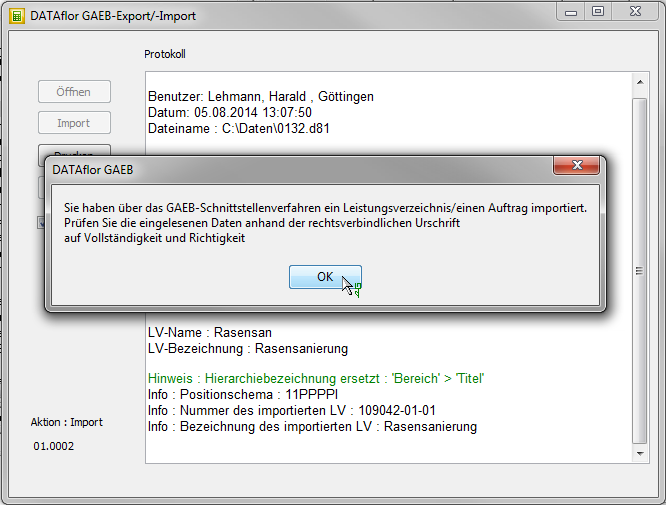
You can then print the protocol.
Export GAEB file
You can use this function to generate service specifications in the GAEB 90 and GAEB XML format BUSINESS output.
Before you output a GAEB file, please check that a GAEB format has been set for the LV (if GAEB files are read in, the program takes over this step for you).
Select the LV in the project management, open in the menu Project management the selection menu he grunted and select the entry Export GAEB-LV.
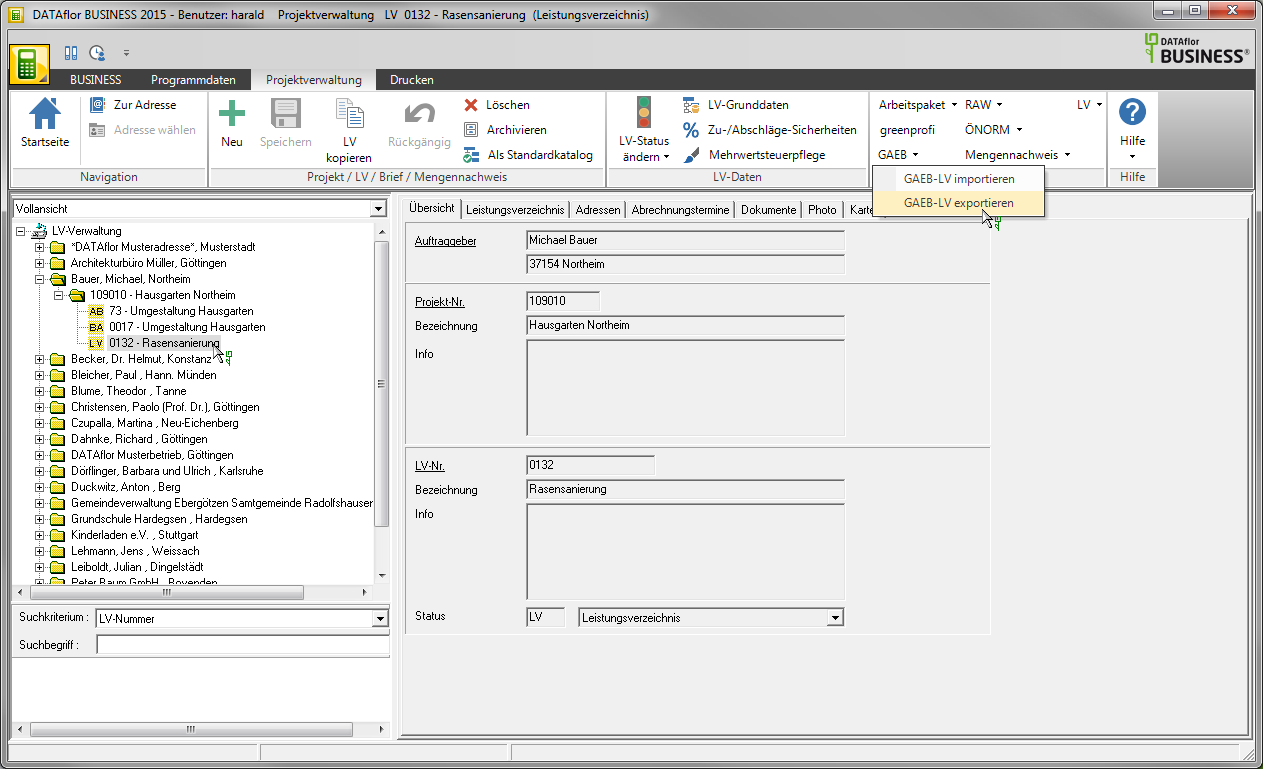
The following window will open.
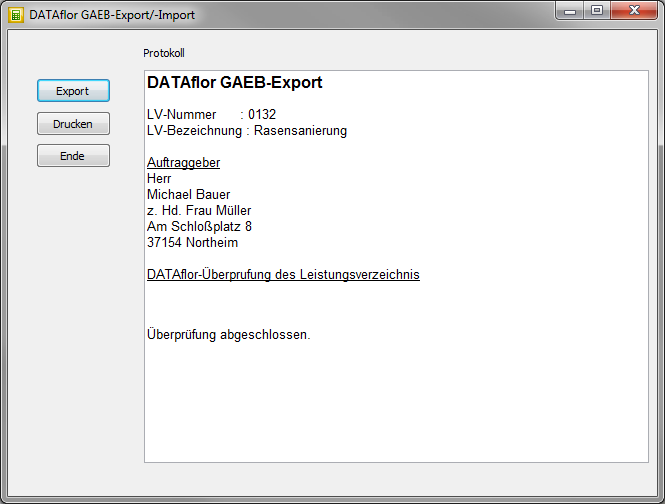
click on [Export]to start creating the GAEB file. Define the file name, file type (GAEB file extension depending on the exchange phase) and storage location and confirm with [To save].
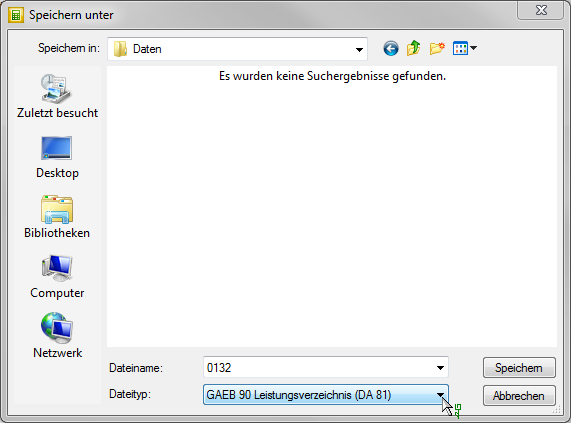
The successful export is then confirmed and messages about any changes made by the program are displayed.
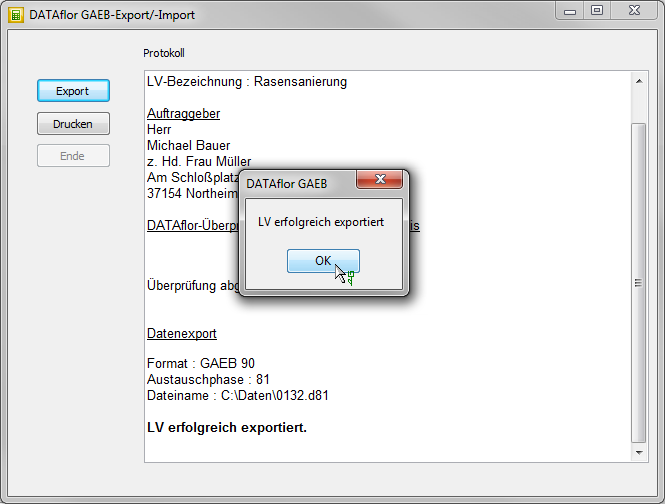
You can then print the protocol and send the GAEB file to the recipient.
RAW interface
RAW is a standard used for electronic data exchange in the Netherlands. Similar restrictions apply as at GAEB. You can create specifications in RAW 3.13 format and RAW XML in BUSINESS import and export.
Import RAW LV
First select the project in the project management for which you want to import the course. Then open the menu Project management the selection menu RAW and select the entry Import RAW LV.

The following import dialog opens.
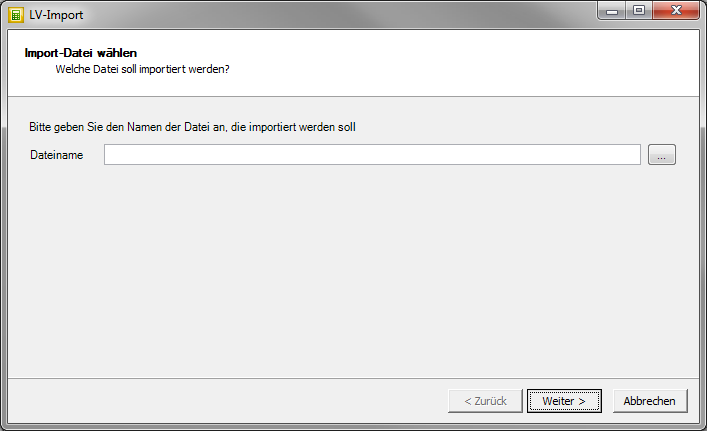
Follow the instructions in the dialog.
Export RAW LV
Select the LV in the project management, open in the menu Project management the selection menu RAW and select the entry Export RAW LV.
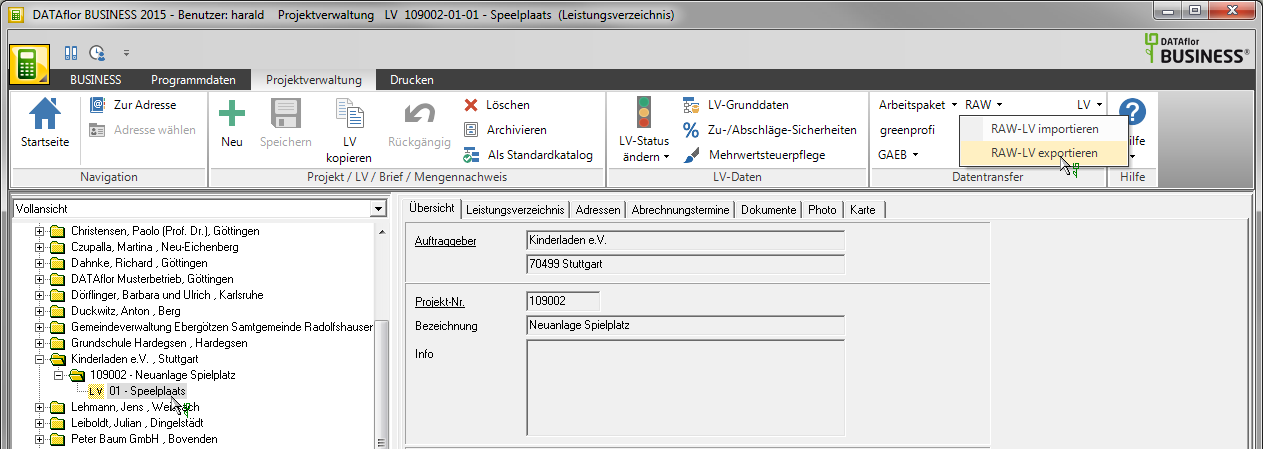
The following export dialog opens.
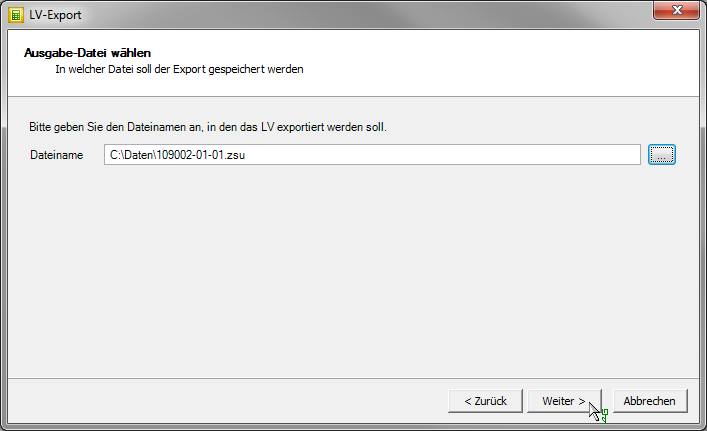
Follow the instructions in the dialog.
ÖNORM interface
ÖNORM is a national standard from the Austrian Standards Institute that is used for electronic data exchange in Austria. Similar restrictions apply as at GAEB. You can import and export service specifications in the format ÖNORM A 2063 and ÖNORM B 2063.
Quantity certificates created for ÖNORM-LV can be output via the separate quantity certificate exchange.
ÖNORM A 2063
The steps from the offer to the invoice for specifications in the format ÖNORM A 2063:
1. Read in request for offer (* .ONLV)
2. Calculate the offer
3. Print offer and / or output offer file (* .ONLV)
4. Placing an order
5. Read in status change from AA to BA / BB or order LV (* .ONLV)
6. Megennachweis in the format ÖNORM A 2063 or DATAflor invest
The ÖNORM A 2063 format is mandatory if the proof of quantity is to be submitted electronically.
7. Print the invoice and, if necessary, a proof of quantity
8. Output the billing specification as a file (*. ONRE)
According to the definition of ÖNORM A 2063, a Accounting file (* .ONRE) two parts composed: part quantities and part accounting. For partial and final invoices, the standard specifies that the quantities in Part billing can Total quantities (cumulative) and in Part quantities only the difference to the previous partial invoice.
This results in a separate handling of quantity statements, quantity statement summaries and invoice printing, which is described below.
1. Advance invoice:
- Creation of the first proof of quantity (MN1) and recording of the service provided
- Printing of the first partial invoice (1st AR) according to MN1
- Export the ONRE-LV by positioning it in the construction site account on the 1st AR and selecting the export function. The data of the selected invoice and the active quantity certificate MN1 are exported.
2. Advance invoice:
- Creation of a new, empty quantity certificate (MN2) and recording of the service provided since the 1st AR
- Creation of a summary of quantities (MNZ1), which contains MN1 and MN2
- Printing of the second advance invoice (2nd AR) according to MNZ1
- Export the ONRE-LV by marking the 2nd AR in the construction site account. The data of the selected invoice and the still active MN2 quantity certificate are exported.
Financial statements:
- Creation of a third, empty quantity certificate and recording of the service provided since the 2nd AR
- Creation of a new quantity statement summary (MNZ2), which contains MN1, MN2 and MN3
- Printing of the final invoice according to MNZ2
- Export the ONRE-LV by marking the final invoice in the construction site account. The data of the selected invoice and the still active MN3 quantity certificate are exported.
ÖNORM B 2063
The steps from the offer to the invoice for service specifications in the format ÖNORM B 2063:
1. Read in request for offer (* .DTA)
2. Calculate the offer
3. Print offer and / or output offer file (* .DTA)
4. Placing an order
5. Status change from AA to BA / BB
6. Megennachweis in the format ÖNORM B 2114 or DATAflor invest
The ÖNORM B 2114 format is absolutely necessary if the proof of quantity is to be submitted electronically.
7. Print the invoice and, if necessary, print the quantity statement or output it as a file
Import ÖNORM-LV
With this function you can create service specifications in the format ÖNORM A 2063 (* .ONLV) and ÖNORM B 2063 (* .DTA) in BUSINESS Read.
First select the project in the project management for which you want to import the course. Then open the menu Project management the selection menu ÖNORM and select the entry Import ÖNORM-LV.
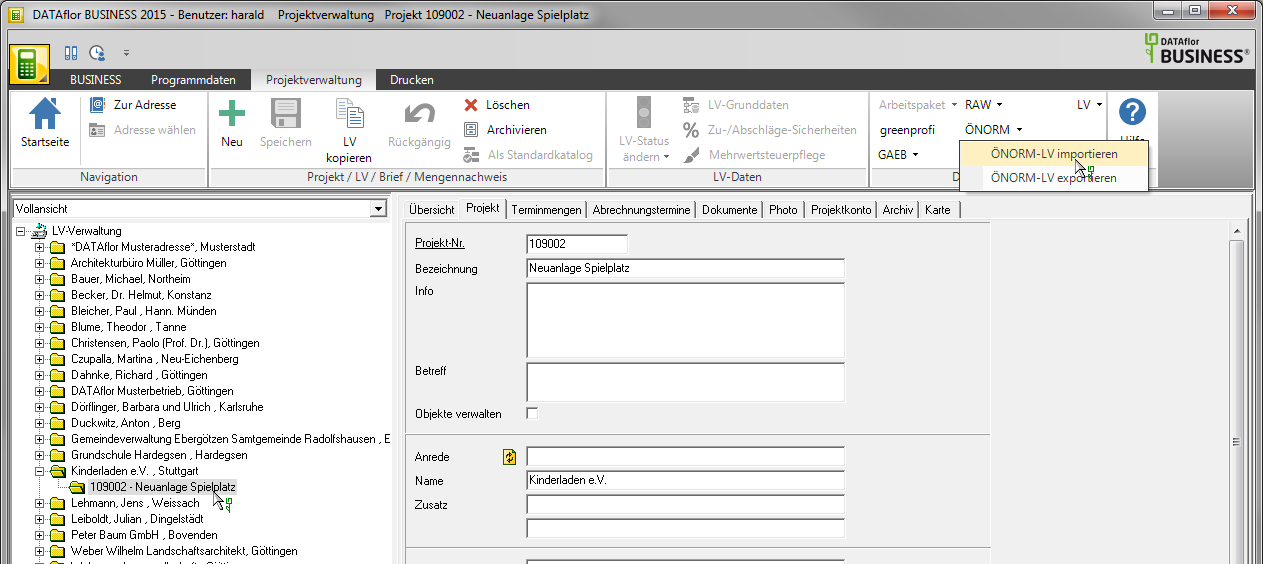
The following import dialog opens. Enter the directory path in which the exported LV is saved or open the Windows file selection dialog.
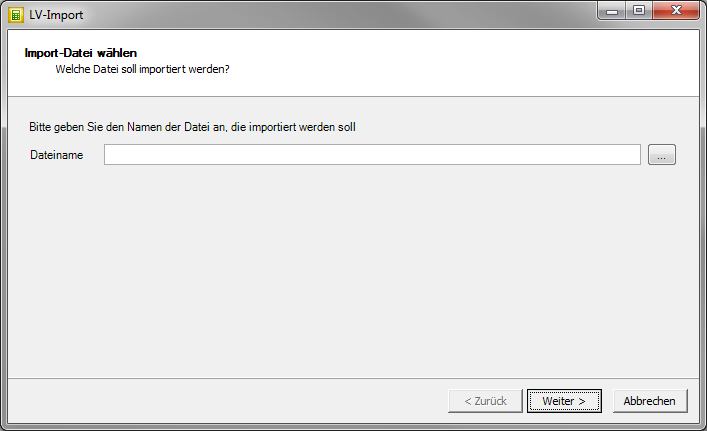
Select the file with the exported LV and confirm with [To open].
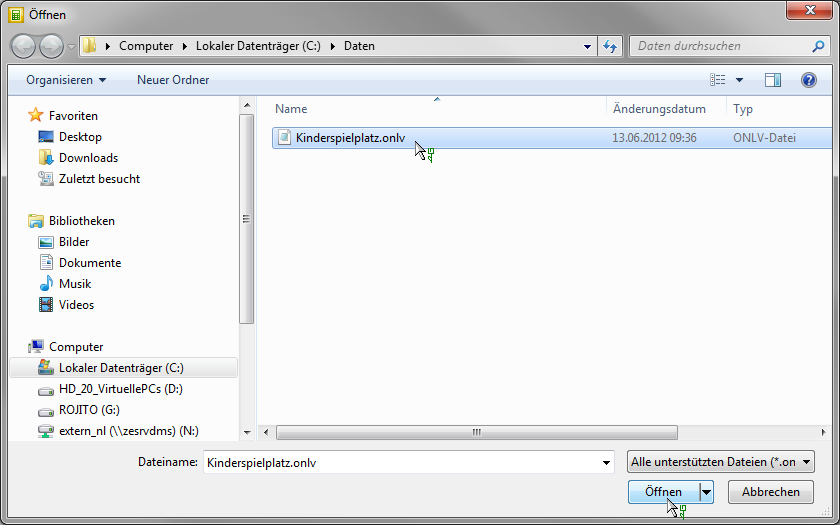
The selected directory path is adopted in the import dialog. Confirm the file selection with [Continue].
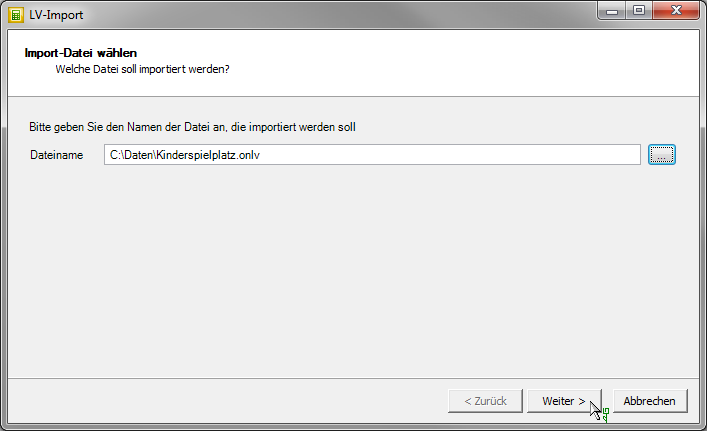
The file to be imported is checked. If the file is free of errors, click [Continue].
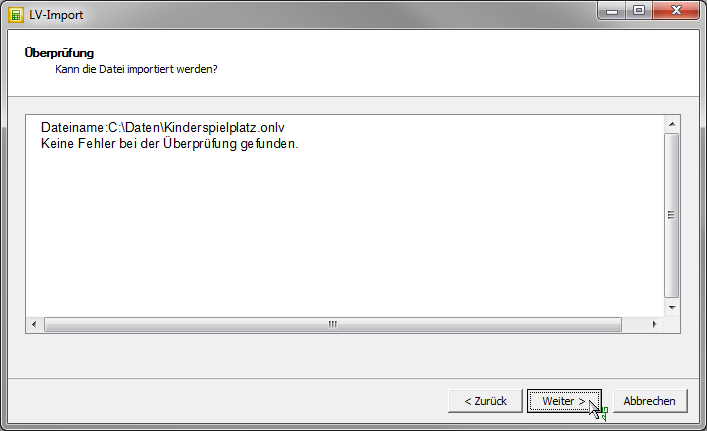
Define the name of the specification of services and assign a business area, work area, LV identifier and tax rate to the specification of services. Confirm your settings with [Continue].
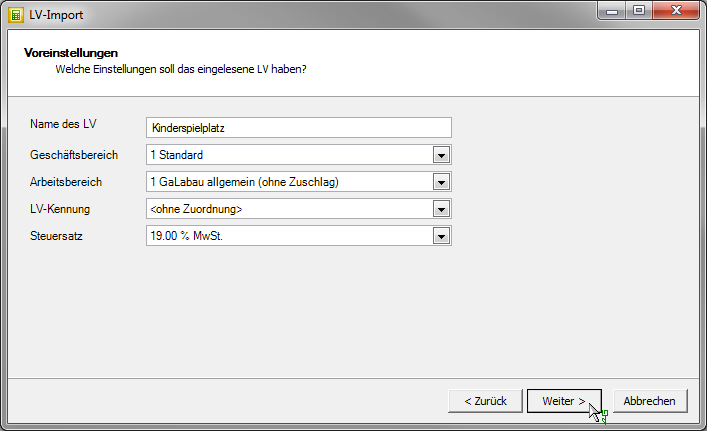
Specify whether all items are set to offer / not offer and specify the number of decimal places for the quantity. After you have made all the necessary settings, start the import process with [Import].
- Positions that on offer are set, but for which no price is entered or calculated, offer 0,00 EUR for the price! We recommend that you first open all positions when importing not to offer to set and only during the calculation of the offer prices for each item individually in the item data on the status offer switch.
- For the electronic exchange of ÖNORM-LV, ÖNORM A 2063 stipulates three decimal places for the quantity. The subsequent Change the number of decimal places for the quantity is possible for each item individually in the item data.
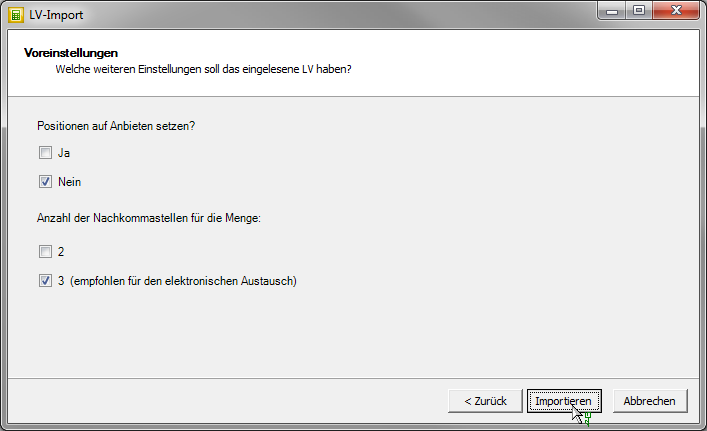
The import process is carried out.
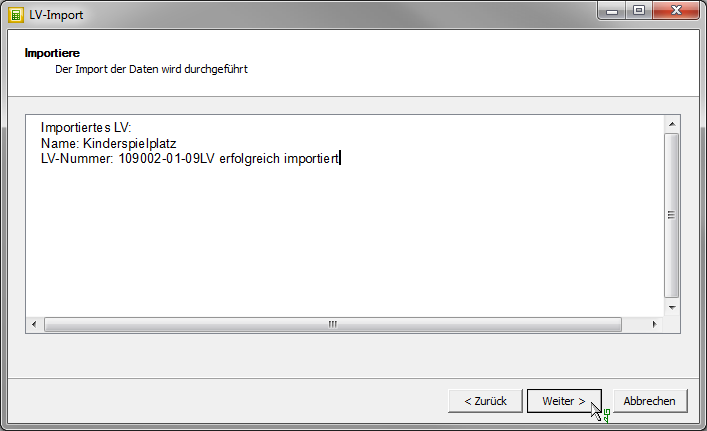
Confirm the successful import with [Complete].
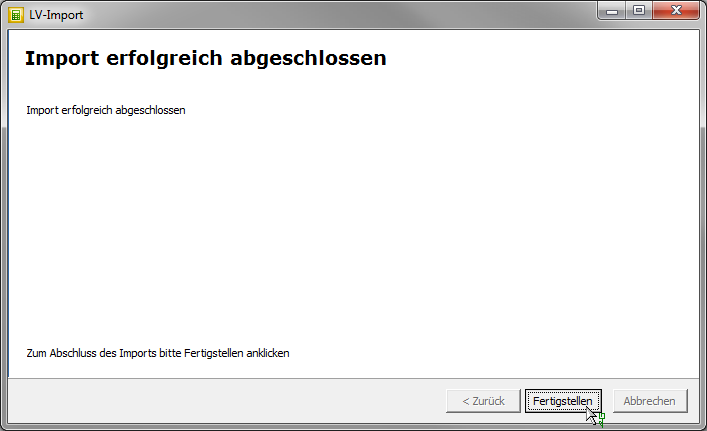
The imported LV is displayed in the project management in the selected project.
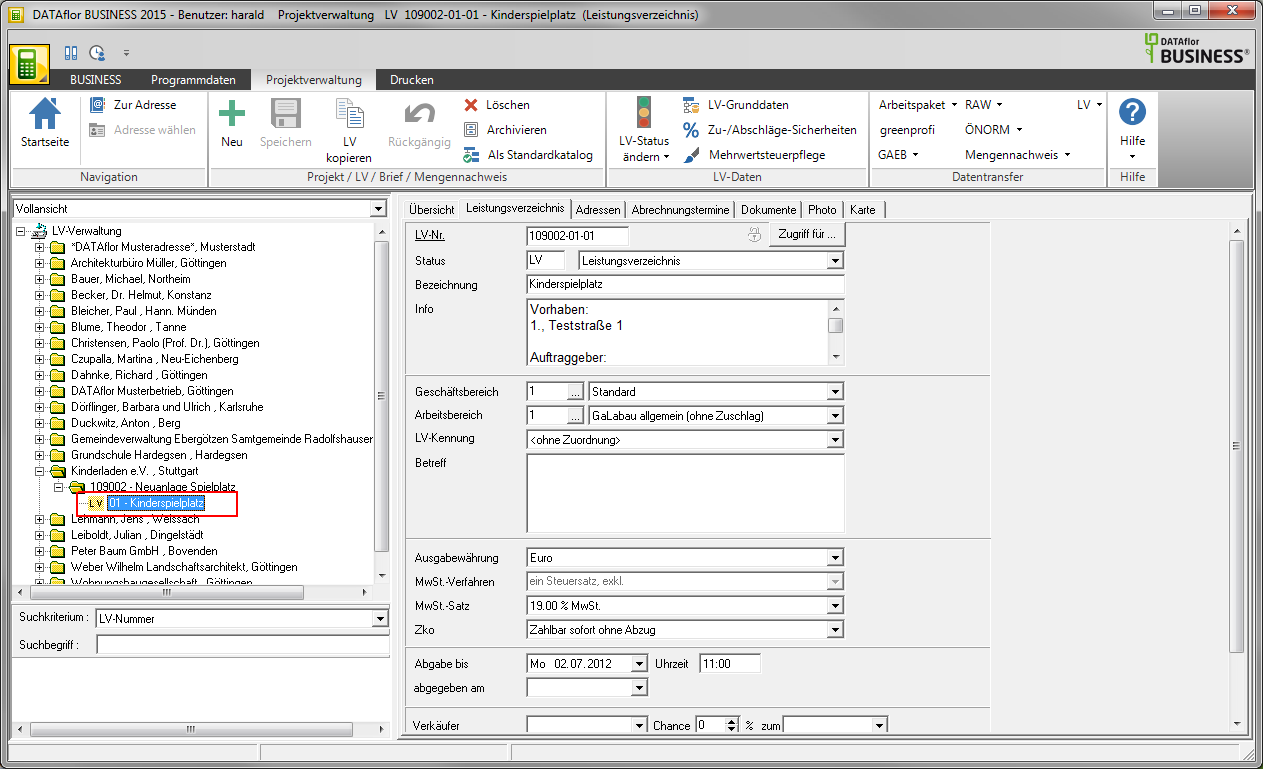
ÖNORM additional offers
You can add additional offers (* .ONLV) in BUSINESS import as well as in BUSINESS create new additional offers:
1. To import an additional offer, select the order specification in the project tree in the ÖNORM A 2063 format, for which you have received the additional offer from the client, and use the function Import ÖNORM-LV.
1. To create an additional offer, select the order specification in the ÖNORM A 2063 format in the project tree and use the function Create supplementary offer. Make sure that the supplementary specification follows the same classification scheme as the order specification and that the hierarchies and positions are numbered correctly, e.g. title = ZA, Component = ZA.01 and position = ZA.01.01
2. Enter your offer prices for the additional offer and export the offer prices as an ONLV file.
3. After placing the additional order, use the function Addendum to the order. For the automatic numbering of the additional items in the order specification, you should definitely use the option Maintain atomic number.
4. The additionally ordered items are now available in the order specification for recording the quantities executed and for billing.

